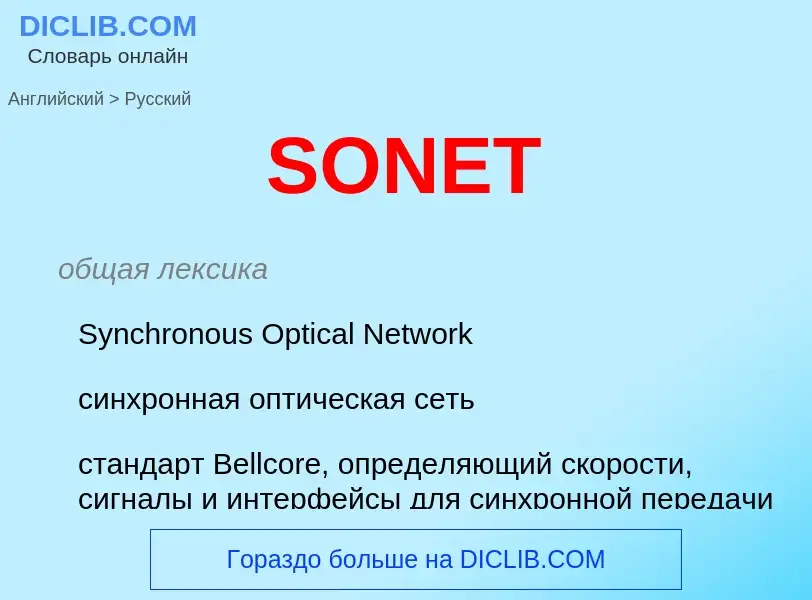Traduzione e analisi delle parole tramite l'intelligenza artificiale ChatGPT
In questa pagina puoi ottenere un'analisi dettagliata di una parola o frase, prodotta utilizzando la migliore tecnologia di intelligenza artificiale fino ad oggi:
- come viene usata la parola
- frequenza di utilizzo
- è usato più spesso nel discorso orale o scritto
- opzioni di traduzione delle parole
- esempi di utilizzo (varie frasi con traduzione)
- etimologia
SONET - traduzione in russo
Wikipedia

Synchronous Optical Networking (SONET) and Synchronous Digital Hierarchy (SDH) are standardized protocols that transfer multiple digital bit streams synchronously over optical fiber using lasers or highly coherent light from light-emitting diodes (LEDs). At low transmission rates data can also be transferred via an electrical interface. The method was developed to replace the plesiochronous digital hierarchy (PDH) system for transporting large amounts of telephone calls and data traffic over the same fiber without the problems of synchronization.
SONET and SDH, which are essentially the same, were originally designed to transport circuit mode communications (e.g., DS1, DS3) from a variety of different sources, but they were primarily designed to support real-time, uncompressed, circuit-switched voice encoded in PCM format. The primary difficulty in doing this prior to SONET/SDH was that the synchronization sources of these various circuits were different. This meant that each circuit was actually operating at a slightly different rate and with different phase. SONET/SDH allowed for the simultaneous transport of many different circuits of differing origin within a single framing protocol. SONET/SDH is not a complete communications protocol in itself, but a transport protocol (not a 'transport' in the OSI Model sense).
Due to SONET/SDH's essential protocol neutrality and transport-oriented features, SONET/SDH was the obvious choice for transporting the fixed length Asynchronous Transfer Mode (ATM) frames also known as cells. It quickly evolved mapping structures and concatenated payload containers to transport ATM connections. In other words, for ATM (and eventually other protocols such as Ethernet), the internal complex structure previously used to transport circuit-oriented connections was removed and replaced with a large and concatenated frame (such as STS-3c) into which ATM cells, IP packets, or Ethernet frames are placed.
Both SDH and SONET are widely used today: SONET in the United States and Canada, and SDH in the rest of the world. Although the SONET standards were developed before SDH, it is considered a variation of SDH because of SDH's greater worldwide market penetration. SONET is subdivided into four sublayers with some factor such as the path, line, section and physical layer.
The SDH standard was originally defined by the European Telecommunications Standards Institute (ETSI), and is formalised as International Telecommunication Union (ITU) standards G.707, G.783, G.784, and G.803. The SONET standard was defined by Telcordia and American National Standards Institute (ANSI) standard T1.105. which define the set of transmission formats and transmission rates in the range above 51.840 Mbit/s.



